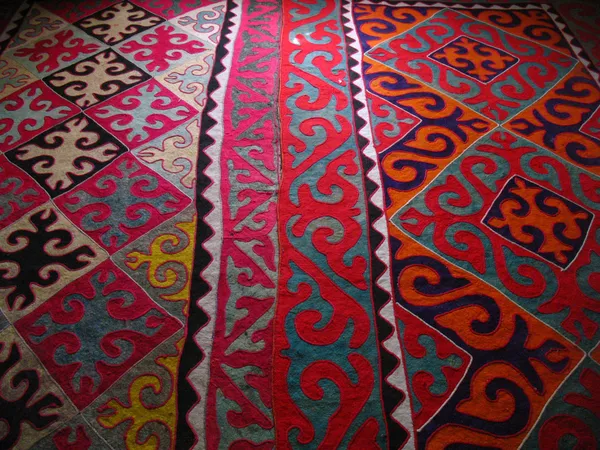When making a felt rug in Kyrgyzstan, you don’t begin with sheep. You start with sedge grass. Women venture into the fields and pluck the reeds while around them goats and horses browse the fields and snowy mountains sprawl toward the sky. Learned hands bind hundreds of reeds into a rug-sized mat that, when finished, looks like a massive bamboo sushi roller. It is in this mat–the chii mat–that the wool is rolled, soaked with boiling water, and stomped into felt.
An entire village is needed to make a shyrdak, the felt rug that is just as important to Kyrgyz culture as carpet-weaving is to Iranians. In nomadic times, shyrdaks were given as gifts or dowry payments. They were not commercially produced until the Soviet years, when folk art was studied, recorded, and “professionalized,” and traditional artists were given state support to pursue their craft. Now the shyrdak is one of Kyrgyzstan’s largest tourist exports, a lifeline for communities that have been hobbled by economic, political, and demographic crises since 1991.
While the women work, the village children wait outside their homes. You might see one in a Mickey Mouse t-shirt, or Angry Birds, or Hannah Montana. When the rug is rolled, it is the children’s job to stomp it.
Defying Categorization
A month ago, I was on my family farm in Manitoba, but today I’m in the mountains of Kyrgyzstan, drinking horse milk, woozy from the altitude. The landscape is unlike anything I’ve seen. Emerald hillsides spill upward into icy peaks tiaraed by mist. Chasms yawn, their floors webbed with sapphire streams, dotted by yurts that tourists can rent if they want to cosplay as nomads for a night or two. The fir trees are dark green spears. The air is icicle clean. No wonder Kyrgyzstan was a popular vacation spot for Soviet citizens.
I came to Kyrgyzstan to meet my girlfriend Begaiym’s family, but there was more I wanted to do. Even before meeting Begaiym, the region of Central Asia fascinated me. It boasts a mix of cultural and political influences unlike anywhere else in the world: Islam, shamanism, Russian customs, the horse-loving traditions of Turkic nomads, and the enduring imprint of the USSR.
The geopolitics of Central Asia interest me too. After the Soviet collapse, Western companies and governments pounced on the region, hoping to tap its previously inaccessible resource wealth and strategic value. In Kazakhstan, Chevron found vast oil deposits to exploit and a highly repressive government to help exploit them. In Uzbekistan, the US government discovered a strategic spot for a military base. And in Kyrgyzstan, the US dropped an airbase, while Canadian mining companies leapt to extract the lucrative gold reserves tucked away in the Kyrgyz mountains, keeping most of the profits for themselves.
At the same time, the states of Central Asia have tried to maintain a balancing act between the US, Russia, and China. In Kyrgyzstan, vying factions have aligned with either the US or Russia in their efforts to seize power. As such, three revolutions have rocked the country over the past eighteen years: 2005, 2010, and 2020. There was a direct US hand in bringing reviled dictator Kurmanbek Bakiyev to power in 2005, and a softer Russian hand in overthrowing him in 2010. Meanwhile, the 2020 revolution that lifted current leader Sadyr Japarov to the presidency has moved the country closer to Russia once more.
For many people in the West, Kyrgyzstan defies categorization. Begaiym is used to people greeting her with “ni hao” or “konnichiwa,” used to their blank stares when she tells them her first language is Russian. Further explanation generates more confusion. Kyrgyz people look Chinese, but they speak Russian? And they’re Muslim? For people unfamiliar with Central Asia, the region can seem like a jumble of characteristics from other countries. It has the brutalist architecture of post-Soviet states, people who often look Chinese to Westerners, and the “-stan” suffix that many associate with poverty, war, and Islam. But it is a nation with an immensely rich history and culture, one that deserves to be understood and respected on its own terms.
Kyrgyzstan’s Soviet history captivates me most. The USSR was what drew me to history as a scholarly discipline in my undergraduate studies. As such, I planned to use every opportunity during my travels to ask older people how they remembered Soviet communism, and how it compared to contemporary life under capitalism.
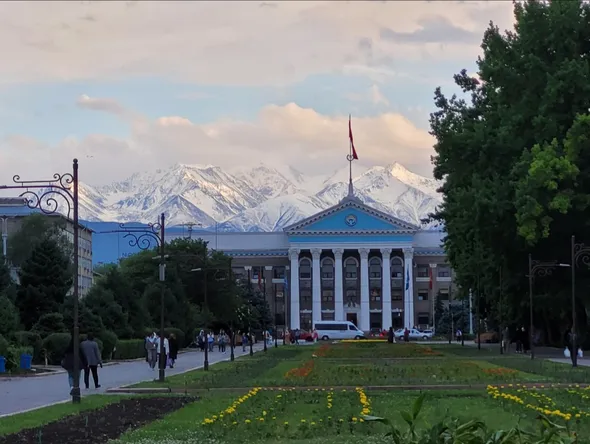
But I also had to see the sights. From Bishkek, it took me, Begaiym, and Begaiym’s parents an hour to reach the Ala-Archa mountains. The snow-caked summits loom surreally close to the city. From almost anywhere, you could look toward the skyline and see crumpled mountaintops, their crags draped with snow so only the most severe edges stood out, black and knife-like.
Seeing The Sights
Begaiym’s father, Nurlan, drove. Her mother, Aliya, sat in the passenger seat. Because I was a foreigner, as well as her daughter’s boyfriend, she worried how I was faring in this new land—if I was sunburnt, if my stomach was okay, if there were unfamiliar ticks in the grass. Neither of them spoke English, so Aliya’s concerns were filtered through Begaiym (“She wants you to cover your arms with this blanket”) as were Nurlan’s questions (“He wants to know if you believe in God”).
Midway up the mountain, I made the mistake of asking her parents a question out of simple curiosity: “Did you like living in the Soviet Union?”
A pause. “Da,” said Nurlan in a deep, serious voice. “Nyet,” said Aliya. And the argument began, with Europe’s “The Final Countdown” playing on the radio, prayer beads swaying on the rear-view mirror as we navigated circuitous mountain roads.
“Life was better in the Soviet Union,” Nurlan insisted. “People respected each other, regardless of nationality. There was peace. Azerbaijan never fought with Armenia,” he said, referencing the recent Azeri-Armenian war over Nagorno-Karabakh, “and Tajikistan never fought with us.” He was referring to clashes in early 2022 between Tajik and Kyrgyz forces in the border region of Batken, which led to over 120 deaths and the evacuation of 136,000 people.
Aliya shook her head. “There were no wars, but that’s because there was no freedom. Russia ruled those countries. They couldn’t go to war if they wanted to.”
“Yes, that’s my point. They couldn’t go to war.”
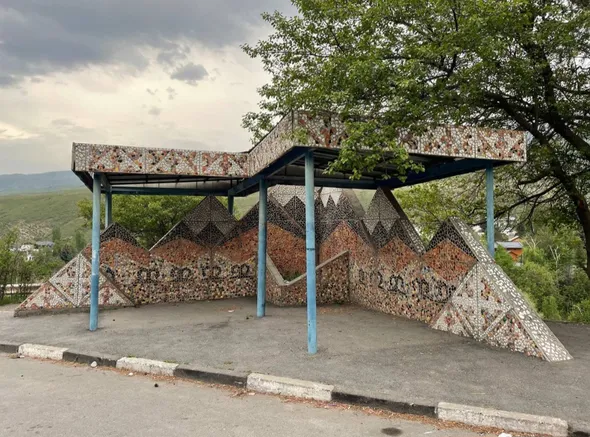
Of course, I didn’t know my innocent question had sparked a rift. Begaiym translated their argument after the fact. For the entirety of the dispute, I gazed out the window, blissfully unaware of the squabble I’d started, marvelling at Soviet bus stops and shepherds who thumbed smartphones while their sheep grazed.
*****
Once the wool is washed and sorted, the entire coat is spread on the chii reed mat. Hot water is sprinkled over the wool to make it easier to compress. Then the chii is rolled up. Wool squishes. Hands get wet as water squeezes through the gaps in the reeds. More water is poured over the rolled mat, which is wrapped in a tarp and tied tight with ropes.
Now the stomping starts. One of the village men grabs the ropes and walks backward, rolling the rug toward himself while a half dozen kids kick and stomp it, laughing all the while. The bundle is like a living thing when beaten. Water spurts. Chii reeds crack like bones. While the children pound the rug, the women break for tea and snacks.
Victory Day
Victory Day in Bishkek. On the façades surrounding the State History Museum—an imposing cube of white marble—ripple red and yellow banners displaying grim-faced veterans alongside glowing hammers and sickles. In Kyrgyzstan, veterans are proud of their service during the Great Patriotic War—more than that, they’re proud to be associated with the hammer and sickle, with the red flag. As a Westerner raised to believe citizens in the post-Soviet world reject everything the former system stood for, I was shocked to see the Kyrgyz people’s enthusiasm for the USSR. Strolling through Victory Day commemorations, speaking to people in Bishkek, I began to realize that Aliya’s viewpoint is the minority.
Polling firmly supports my impression. According to Gallup, only 16 percent of Kyrgyz people say their country benefitted from the breakup of the USSR. The older generation—those who lived through the communist period—are more likely to lament the transition to capitalism.
“You can often hear older people saying, ‘Give the Soviet Union back to us,’” Begaiym told me. “People remember the stability. Back then, they had confidence in their future.”
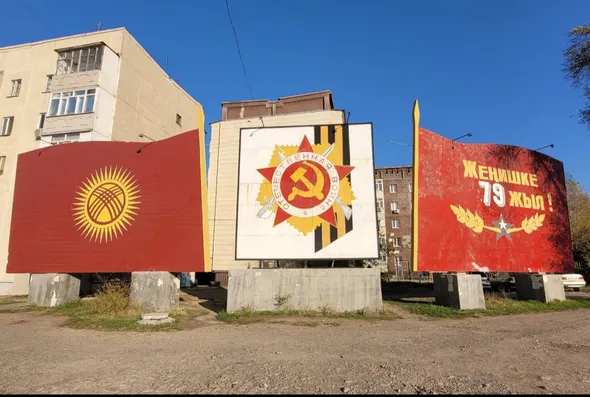
Like the banners outside the State History Museum, the ribbons that citizens don to mark the Soviet Union’s victory over fascism are red and yellow, the colours of the national flag, not the black and orange of the Ribbon of Saint George that is still used in Russia and some post-Soviet states. It’s a small change, but one taken to mark Kyrgyz independence after 1991. Throughout Bishkek, other changes were made to assert Kyrgyz culture after the Soviet collapse. The city was renamed from Frunze, the surname of a Bolshevik general born in Russian Turkestan, to a variation on the pre-Soviet name of “Pishpek,” the word for the spoon used to churn fermented horse milk. The new capitalist rulers rechristened streets and replaced statues. In front of the State History Museum, Lenin was supplanted by Manas, the legendary hero who is said to have united forty tribes into the modern Kyrgyz people. These changes were accompanied by political and economic reforms that supposedly aimed to build a Western-style representative democracy on the skeleton of the Soviet state.
As anyone in Kyrgyzstan will tell you, promises of democratization and consumerist splendor have not borne out. Whether allied with Washington or Moscow, the capitalist state remains weak, corrupt, and oligarchic. Kyrgyzstan was impoverished during the USSR, and it is still poor today, but now without the social guarantees of the communist era: free and accessible healthcare, universal education, guaranteed employment. A lack of jobs in rural areas has forced working-aged people to travel to Russia for employment, contributing to mass depopulation. Meanwhile, everyone Begaiym’s age wants to study abroad. That’s how we met: she came to Manitoba for school. Because so many people are leaving the country for work and education, it is now common to refer to Kyrgyzstan as a nation of children and seniors.
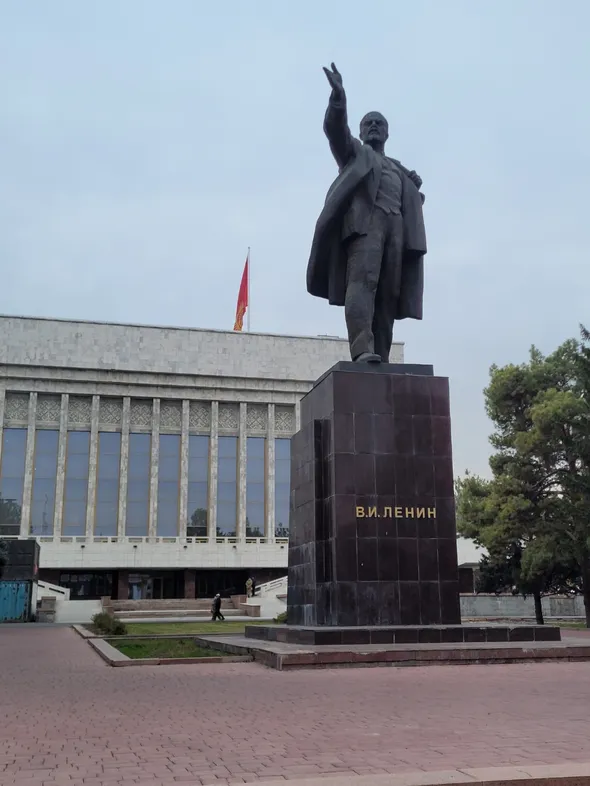
As the Kyrgyz state eroded under market reforms in the 1990s, international organizations and “civil society” colonized many of the buildings constructed during the Soviet era. At the same time, Western companies poured into Bishkek: European clothing brands, iStores, and a surprising number of KFCs, by far the most popular fast-food restaurant in Bishkek for reasons that escape me. You’re now just as likely to see young people wearing swag from US universities, widely available in the capital, as the traditional ak-kalpak hat.
Under these cultural, political, and economic changes, the presence of the Soviet Union is still felt. It isn’t just the fading murals that speckle the city—scenes of workers clumped in solidarity, noble soldiers repelling the Nazi advance, socialist astronauts conquering the stars—or the sun-bleached Lenin profiles emblazed on old buildings, or the Bishkek war memorials, one of which proclaims, “We went to fight for communism!” It persists in the minds of those who lived through the Soviet years. The new Kyrgyz state understands the power of that legacy. That’s why, on Victory Day, it unleashes the symbolism of the Soviet Union in a wave of hammers and sickles, rousing the patriotism of the older generation.
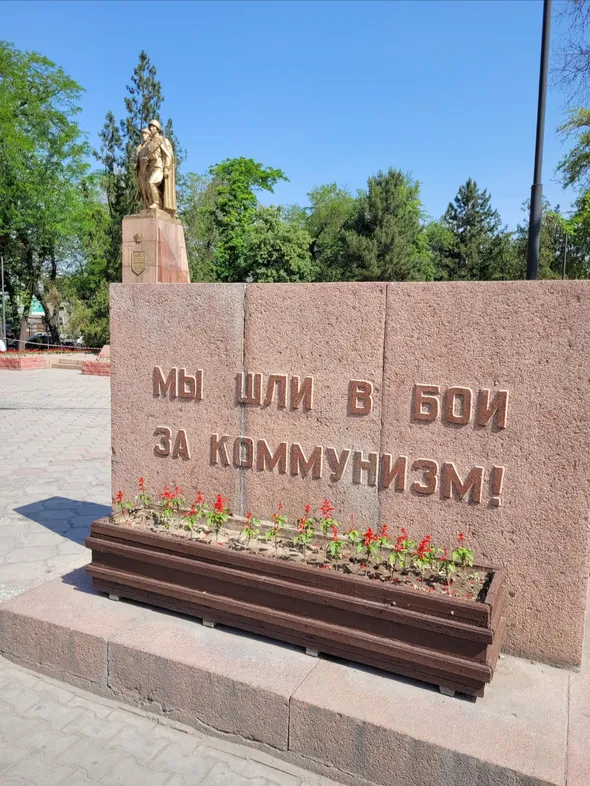
Gazing out across the museum square, I see fragments of ancient Kyrgyz history, the more recent Soviet past, and today’s consumer capitalism. Historians view these epochs as strata, a sedimentation whose layers build on one another in a linear fashion, but from my vantage point, I see everything at once: the bronze statue of Manas, regal and horsebound as he leads the forty tribes toward a sea of hammers, sickles, and KFCs.
I recall this moment later, during a conversation with Begaiym’s uncle Bekjan, brother of Aliya. He is a jovial man, always grinning, with a solid build even though his days as a boxer are long behind him. To me, he embodies Kyrgyz hospitality. Within a few hours of meeting him, he was pouring me shots of balsam (a Kyrgyz herbal liquor), teaching me to play nardy (a Russian version of backgammon), and offering to take me to a banya (a Russian sauna).
After the first shot of balsam, which tastes a lot like Jägermeister, he proudly held up the bottle: “During the Soviet Union, we had great scientists. They figured out the exact blend of herbs and spices to create a perfect balsam. The Soviet Union led the world in science and sport.” Later, Begaiym showed me pictures of Bekjan from his boxing days. His nose was broken in many of them, injuries inflicted in the ring.
Complicated History
A week after Victory Day, I joined the family for dinner at Pishpek, a restaurant that sells traditional dishes like beshbarmak, manti, and chuchuk, a delectably greasy horse sausage. The walls were decorated with paintings of warriors on horseback, mountain ranges, and black-and-white photographs of Bishkek from back when it was called Frunze. Partway through the meal, Bekjan ushered me into an adjoining room. He showed me pictures on the wall: the construction of the airport, the history museum, the gateway to Osh Bazaar. “Before the Bolshevik revolution,” he said, “there was nothing here but a road and some yurts. Our relationship with Russia is complicated,” he conceded, “but it’s history. In 1916, for example, Kyrgyz people revolted against the Russian Empire and the tsar oppressed them.” Bekjan was referring to the Urkun, a rebellion of Central Asian peoples, mostly Kyrgyz, against imperial Russia that saw hundreds of thousands killed. “But when the Soviets took over, they built cities, roads, infrastructure, housing. Diets improved. That is why we love the Soviet Union. We lived better, and we had hopes for our futures. All that changed in the ‘90s.”
In that moment, I thought back to Victory Day, to Manas encircled by hammers and sickles and Colonel Sanders’ smiling visage. I considered the Soviet nostalgia I’d seen amongst many older people in Central Asia, and all the young people wearing t-shirts of US pop culture, US cities they’ve never visited, US universities they’ve never attended. I realized there is a profound disconnect between the generations: between the seniors and middle-aged people who once saw the Soviet Union as their guarantor of comfort and stability, and the young people who now see their path to success in the West, with its breathless promises of prosperity.
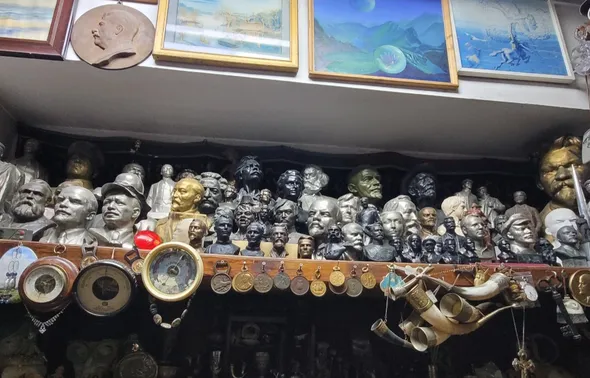
In the void left by the disappearance of Soviet ideology, there is no longer one unifying vision for the nation. “Culture and traditions are keeping people together,” Begaiym told me, “but there is no agreement on what Kyrgyzstan’s future should be. At the government level, there is no ideology whatsoever. If you ask anyone about the government, they will say, ‘The government is on its own, and we’re on our own.’ Nobody expects help from the state.” It’s no wonder so many people yearn for the steadiness of the Soviet days, while others long for a future elsewhere.
*****
When the wool has been thoroughly beaten, the children go back to helping with the sheep and goats. The women unravel the chii and find that what was once three inches of downy fluff has been flattened into a half-inch of dense, scratchy felt as wide and long as a finished rug. They beat it more, then roll the felt into a coil, tie it with ropes, and wash it again in one of the many clear, icy rivers that bubble through the Kyrgyz mountains.
When making a shyrdak, the villagers repeat this entire process once more. One of the felt rugs serves as the carpet’s base, while the other provides the ornamental designs.
A Short Biography
Aliya and Bekjan’s father, Turushbek, has nothing bad to say about Stalin. He thinks Nikita Khrushchev, the architect of destalinization, did nothing worthwhile. Turushbek is still appreciative of the fact that, although he grew up an orphan in the Kyrgyz countryside, he was fed, clothed, and given a free university education under Stalin’s rule, which set him on the path to a career as a mining engineer and geology professor.
For an hour, Begaiym and I sat with her grandfather, sipping tea and munching slivers of cantaloupe, honeydew, and watermelon. He is a short man, eyes narrow, white hair combed into a tight swoop of snow. When I asked him how life was during the Soviet Union, he didn’t say anything, but gave a thumbs up.
“What was different?”
Equality, he said, and employment: “Everyone had a job, and if somebody didn’t want to work, they were forced to work. The people who complained about the Soviet Union didn’t want to work. They just wanted to consume without giving anything back to society.”
Turushbek was born in Osh oblast in 1940, in the “jailoo,” a Kyrgyz word meaning “pasture” that denotes the deep countryside. His mother died in childbirth, so he moved in with his aunt, whom the government gave a cow—a small gift, but one that helped them get by. When his aunt passed away, the villagers loaded him onto a donkey and sent him to an orphanage which, by that time, was packed with war orphans whose parents had been killed on the Eastern Front. “We got three meals a day,” he recalled, “not great food, but enough. We went to school. When we were old enough, we wrote the university entrance exams, and those who passed were able to enroll free of charge.”
Turushbek first studied to be an electrician, then changed his career path to become a mining engineer. He installed electrical grids throughout the USSR and worked at coal mines in Kyrgyzstan, Russia, and other Soviet republics. In one surprising anecdote, he quit his job on a whim and rode the trains to Moscow with a friend from Bashkiria. This was 1961. Their arrival in Moscow coincided with Yuri Gagarin’s return from space. A massive crowd piled into the streets to greet Gagarin, and from the back, Turushbek and his friend caught a glimpse of the first human to journey into outer space, in a country that had been a backward feudal monarchy less than five decades before. When Turushbek returned to Kyrgyzstan, he wasn’t punished for his spontaneous trip to Moscow. In fact, his boss gave him his job back.
“At every turn of this short biography,” Turushbek said, “the state helped me. When my mother died, the government gave us a cow. When my aunt died, the orphanage took me in. When I came of age, I was given the opportunity to study. I was sorry when the Soviet Union fell. The USSR raised me, fed me, clothed me. I will not criticize it.”
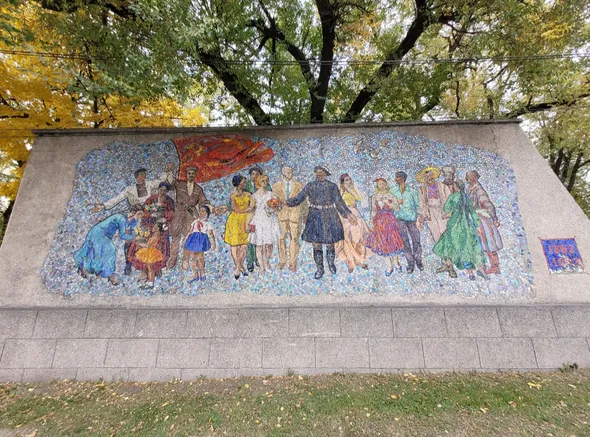
Driving home, Aliya told me and Begaiym not to listen to her father. “The Soviet Union was unequal too,” she said. “There was no freedom. It was a dystopia.”
In the passenger seat, Nurlan said, “What do you mean? You were raised well. You liked growing up in the USSR.”
“That’s because I had no idea what was going on.”
*****
In the comfort of a yurt, the women prepare the yarn. They do this in the company of their daughters and granddaughters, teaching them which wool to keep and which to discard, and how to properly spin the strands into hoona, the dyed threads used to join the two rugs together.
The base layer, made of white wool, is unrolled. The second rug, black, is laid on top and temporarily sewn to the base. Consulting a pattern drawn by a master craftsperson, the women hunch over the rug and trace the designs using chalk or soap. In these patterns –looping rivers, jagged mountain edges, floral motifs – centuries of Kyrgyz philosophy are encoded. They are a secret language, a calligraphy of ornaments meant to impart wealth and ward off misfortune. The triangle, or tumar, is a talisman against evil. The spiral of a ram’s horn signifies wealth. The curl of a crow’s claws represents the passing down of tradition.
Karl Marx In A Hailstorm
A few weeks after visiting the Ala-Archa mountains, we embarked toward another stunning Kyrgyz locale, Lake Issyk Kul, a crystalline body of water fringed by mountains, resorts, and roaming horses. The scenery was breathtaking. During the four-hour drive from Bishkek, we floated through grassy gorges that recalled Scandinavian fjords, sun-baked mesas like the New Mexico desert, serrated mountain ranges as snow-laden as the Rockies, and skirted the sparkling lake where children swam and horses drank water.
On a barren road in a sandy stretch of countryside, we passed through the village of Kara-Koo, which still displays its Soviet-era name on a sign outside town: Karl Marx Collective Farm. In every direction I saw scraggly plants, chunky brown stone. I struggled to see how a farm could have existed here. Begaiym snapped my picture in front of the sign, but as we drove deeper into the village, we found something better.
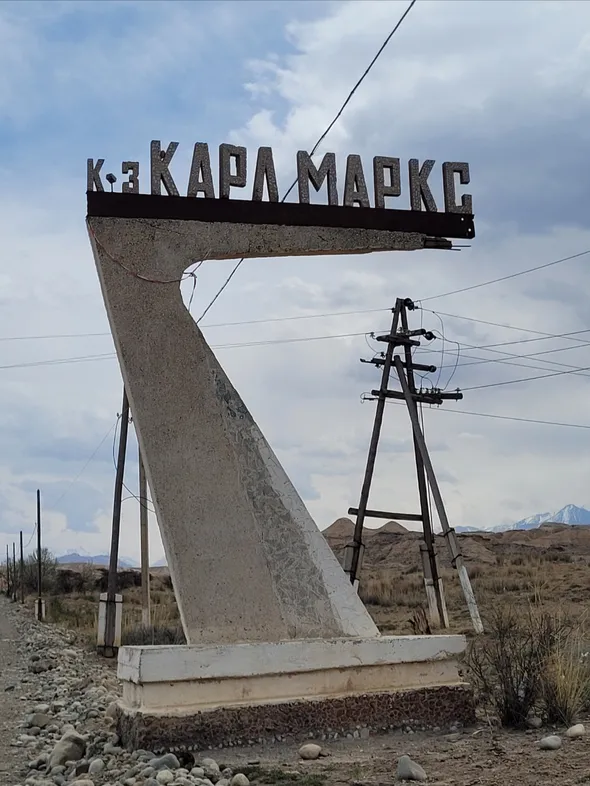
Outside the village’s cultural hall, a squat brick building with the red and yellow Kyrgyz flag flying over it, stood a gargantuan Marx in white marble, at least fifteen feet tall. His arms were crossed, his shoulders wide. His formidable face looked enormous against the backdrop of cloudy sky. The hall was ringed by an iron fence, but Nurlan held the gate open so we could squeeze through.
As I stood at Marx’s feet, waiting for Begaiym to take the photo, I wondered about the history of the statue. When was it built? Who hauled Marx through the protean beauty of northern Kyrgyzstan? From where? Who worked on this collective farm named for a German philosopher, a man who probably seemed quite remote from the daily lives of Kyrgyz farmers?
I wondered about the Soviet years, which so many people miss and admire. I considered the trauma of the USSR’s sudden disappearance from the world stage, from people’s lives, the impoverishment of so many families. And I thought about all the people in Kyrgyzstan, Central Asia, and the whole post-Soviet world who yearn for something better than the corruption and poverty they’ve been stuck with, who look back wistfully on the lost years of stability and look ahead with fear, stress, and uncertainty. I know these people just want to live hopeful lives, which many in Central Asia have struggled to do since 1991—the kind of life where a Kyrgyz orphan from the countryside can become a university professor who once glimpsed Gagarin.
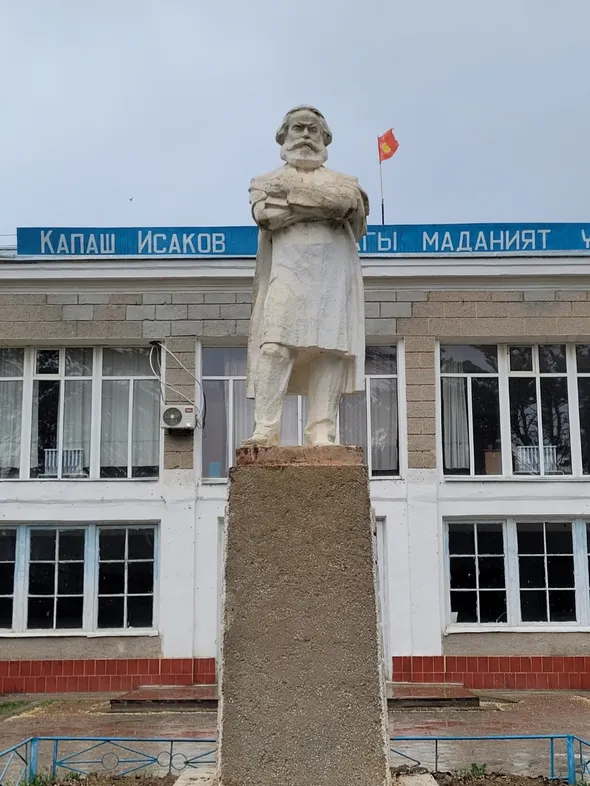
Right after Begaiym took the picture, something smacked the top of my head. Hail. A few seconds later, we were in the centre of a hailstorm, ice shards slugging my shoulders, smashing on Marx’s brow, ringing on the metal gate that Nurlan held open, a cigarette pinched between his lips as he flinched under hail blows. When we tumbled into the car, Aliya was laughing. Ice clumps broke on the windshield, dinged the side mirrors. The roof rumbled like someone was beating it with drumsticks. “Karl Marx in a hailstorm!” Aliya chuckled as Nurlan pulled away, leaving the statue in the dust.
*****
Many Kyrgyz worry that the art of the shyrdak is fading. Cheap synthetic rugs have flooded the domestic market, reducing demand. While the Soviet Union took extensive measures to safeguard traditional felt art, the new government isn’t doing enough to protect the traditions of shyrdak-making from the pressures of globalized capitalism. At present, most shyrdak artists are over forty and there are few young people interested in picking up the craft.
What is the future of the shyrdak in the post-USSR, capitalist world order? Will the shyrdak be reduced to a novelty for tourists? Can felt arts retain their cultural importance as craftspeople are deprived of state support and it becomes harder for them to make a living? Only time will tell.
A Golden Time
Polling firms regularly travel through Eastern Europe, Russia, and Central Asia, asking people questions about the Soviet Union. Consistently, the majority of respondents say they have not benefitted from the introduction of capitalism to their country. They feel that any benefits from the market transition have accrued to business and political elites, while ordinary people have been left in the lurch. I knew about these polls before visiting Central Asia, but even so, I was shocked that everyone I encountered, with the exception of Aliya, expressed overwhelmingly positive sentiments about their lives in the USSR.
In addition to Kyrgyzstan, Begaiym and I travelled through Kazakhstan and Uzbekistan, and everyone we spoke to said the same thing: they missed the USSR dearly. A Tashkent local informed us her country still remembers the USSR as “a golden time.” An Uzbek pensioner who gave us a ride to the train station said his father lived over one hundred years because the Soviet state looked after him. Unlike his dad, the pensioner needs to offer rides at bazaars just to scrape by. “Back then, people didn’t worry about food or medicine,” he said. “Now everything is very bad. The Quran says to treat everyone with respect. The Soviet Union was like that.” And at a market outside the Uzbek capital, an old vendor smiled upon learning I grew up near Winnipeg. “Winnipeg Jets!” he exclaimed in English, before turning to Begaiym and saying in Russian, “Tell him the Soviet hockey teams were better.”
After conversing with residents of Central Asia, seniors and middle-aged people, non-English speakers whose experiences are little investigated in Europe and North America, the abstract percentages of the polls began to concretize. I could tell these people weren’t simply longing for their youths. By and large, their lives have gotten materially worse since 1991. I saw it in the bazaars of people selling anything to survive, from copper pipes to horses to handguns. I saw it in the utter disdain locals expressed for their present circumstances. I saw it in the smiles that creased their faces when I brought up the USSR.
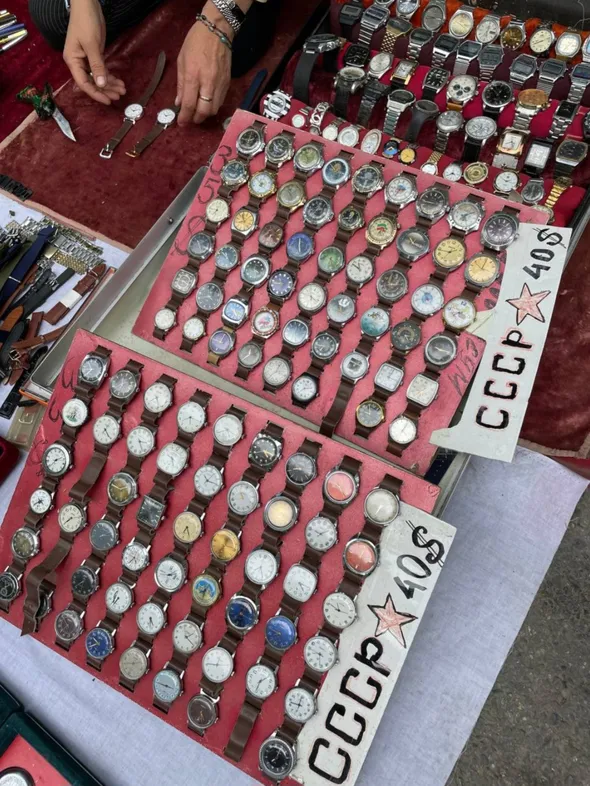
People want stability and social guarantees, but across Central Asia, there is poverty, conflict, and repression. In this context, Western businesses have done very well for themselves, tapping Kazakh oil, mining Kyrgyz gold, flooding Central Asian markets with cheap goods. And they don’t care if local industries, if local people, suffer.
*****
Once the patterns have been traced onto the second rug, the women slice them out using a pair of shearing scissors. The result is a tangle of swoops and curls which, when laid flat on the base layer, possesses the beautiful symmetry of a spider’s web.
The most experienced women sew the ornaments into the base rug using black hoona threads. It is the hoona that gives the shyrdak its breathtaking texture and depth. It is the hoona that attaches the black to the white, one layer of history to another, the eternal language of the Kyrgyz to a backdrop as pristine as the snows of Ala-Archa.
Liked it? Take a second to support Cosmonaut on Patreon! At Cosmonaut Magazine we strive to create a culture of open debate and discussion. Please write to us at submissions@cosmonautmag.com if you have any criticism or commentary you would like to have published in our letters section.
